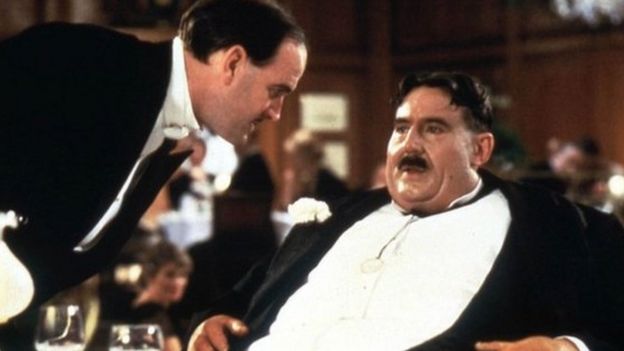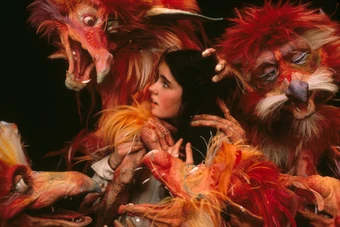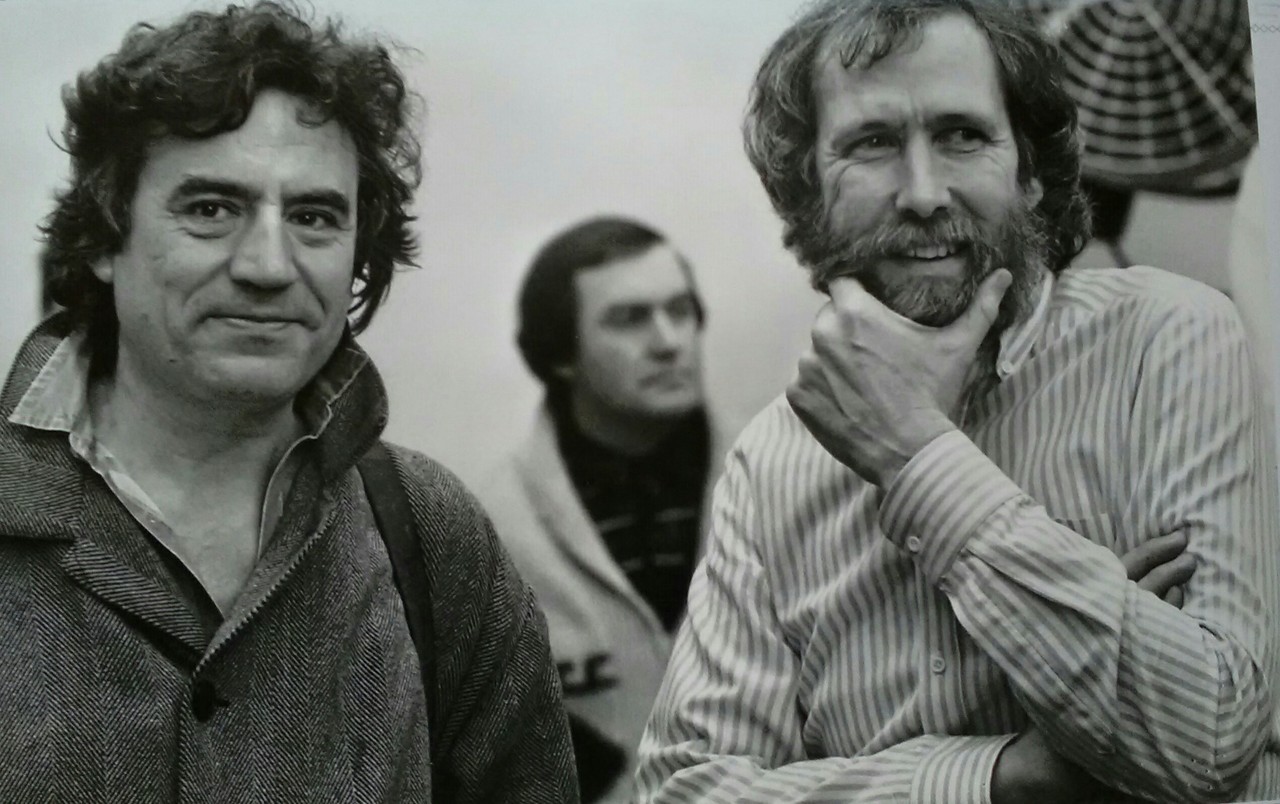Jones wrote and starred in Monty Python's Flying Circus TV show as well as the comedy troupe's films directing Life of Brian and The Meaning of Life and co-directing The Holy Grail with Terry Gilliam.
One of his most memorable Python performances was in The Meaning of Life as the exploding Mr Creosote who, misguidedly accepted "just one wafer thin mint", after a gargantuan feast.

Although Terry Jones isn’t sure how much of the completed film is actually his, he did receive credit for writing the screenplay. Having made a name for himself as a children’s book author, in addition to his Monty Python work, he seemed a logical choice to pen the Jim Henson movie.
Actually it was his second children’s book that led to his collaboration with the Muppet creator, he says. "I had been thinking about turning Erik the Viking into a film, and I thought it was something Jim Henson might be interested in," explains Jones. "I rang up his office, and they said ‘That’s funny – he was trying to reach you yesterday.’ So, Jim and I met up – he was setting up Labyrinth at that stage – and he wanted to know if I would like to write the screenplay.

"Jim's daughter Lisa had just read Erik the Viking and suggested that he try me out as a screenwriter – and that’s how it came about. I hadn’t really known Jim before our labyrinth meeting. We had bumped into each other when the Pythons were first in the States. We were in the street, getting out of cars, when he called out ‘Hi, I’m Jim Henson!’ That was about 1975, but we hadn’t met since then."
Although it was Jones’s screenplay, the original idea belonged to Henson. "Jim had the basic story for Labyrinth," explains Jones, "but I really agreed to do it in the basis of the characters. I wanted to have a fairly free hand at the episodes. I just started fresh, using the same characters. I’d undertaken the thing in a rather cavalier fashion. I’d read their synopsis, and they’d had a novella of the film-to-be. It was about ninety pages of story, and I though it didn’t work at all, so originally I said I wasn’t interested. Then after a couple of bottles of wine with Jim, I said "All right, maybe I’ll spend three weeks writing and see if something comes up.’
"That’s what I did, and it was great. I had all of Brian Froud’s drawings in a stack – he does the conceptual designs and drawings, on which the models are based," he reveals. "I had this pile of drawings, so I sat there with this basic story outline and all these characters. When I came to a new scene, I just picked out a character I liked and wrote a scene around it, like the old man with the hat with the duck’s head, and the hat talks back – it just seemed obvious. It was there in the drawing.

"In some way, Labyrinth was Brian Froud’s project. I think he came up with the idea of doing something about a labyrinth. Whenever I got to a situation where I wanted to invent a character, I would flip through his creations until I came to one that I liked, and give it words – I was collaborating in a funny way with Brian Froud, because I was springing off his drawings."
The film was much like a fairy tale. Because there were only two human stars in Labyrinth, played by Jennifer Connelly as Sarah and David Bowie as Jareth, Jones was able to concentrate much of his attention on the creatures.
"I though the first draft I wrote was pretty good, really. I though it was fun and everyone was excited about it. Then it disappeared for a month, and Jim came back and said ‘We’ve got some problems.’ The main problem was this labyrinth – the original idea was to do this thing about the labyrinth. They wrote this magical character, Jareth, who is all-powerful and does magic. I though there was no contest. This girl goes into the labyrinth, and you’ve got this magic character, so she can’t win.
"So, in my version, she goes into the labyrinth, and eventually finds out there is no solution. She keeps thinking she’s solved it, and then it keeps cheating on her. The idea in the end is that she finds out there is no solution, you’ve got to enjoy it. When she gets to the center, she finds out that the character who seemed all-powerful to begin with isn’t all-powerful. In fact, he’s someone who uses the labyrinth - which is basically the world – to keep people from getting to his heart. She gets there and annihilates him in the end. So, it’s about the world, and about people who are more interested in manipulating the world than actually baring themselves at all, having any kind of emotional honesty. Jim couldn’t understand the story at all.

"The other thing I though was, you mustn’t get to the center before the girl does, because what’s your hook for the audience – what is in the center of the labyrinth? Jim had two problems. One was that Jim wanted Michael Jackson or David Bowie to play Jareth, so he wanted him to appear all the way through, and he wanted him to sing. That was a real shock. Then he also wanted to go to the center of the labyrinth before the girl does. Both were things I felt were wrong.
"But I wrote a second version which had Jareth singing. He went for David Bowie, and it all went away for about a year. When the script came back, I didn’t recognise any of it. Jim said ‘Can you do a bit more to it? David Bowie doesn’t want to do it anymore because it wasn’t funny anymore.’
"It was more or less mine until the part where Sarah goes down the Pit of Hands, which was mine. It’s sort of mine up to the point where she east this apple, which is something Jim wanted to put in and I didn’t like it at all – that’s when I though it was no longer mine, it was nothing I had much to do with."
Because of Henson’s story and the changes he made to the script, Jones says he doesn’t feel very close to the movie.
I didn’t feel that it was very much mine. I always felt it fell between the two stories. Jim wanted it to be about one thing, and I wanted it to be about something else. But Jim was great, really smashing to work with – he was kind of person one wanted to do things for because he was so nice and so straight – even when we disagreed on things. He was always open to other ideas.
"The things I liked most about Labyrinth/ are not necessarily things I contributed," notes Jones. "I had an idea to do this Shaft of Hands – she falls down this dark shaft with these hands sticking out, hands all talking to each other – and it actually works! They realised it much better than I imagined it when I wrote it down as an idea. In a way, my best contribution was starting off something that the puppet makers have made much better and improved. I just started the ball rolling, but I think it’s the sequence that works best."
From:
"Life Before and After Monty Python
– The Solo Flights of the Flying Circus"
By Kim "Howard" Johnson
(1993, St. Martin’s Press, New York.)
Below Terry Jones talks about his time working on Labyrinth:
UPDATE:
You can read more about Terry Jones involvement with Labyrinth from Jim Henson biographer Brian Jay Jones here.


No comments:
Post a Comment